In today’s world, keeping your devices charged is a must. Whether you’re at home, in the office, or on the go, a reliable wall charger is essential. But with so many options available, how do you choose the best one? 🤔
Don’t worry – we’ve done the research for you. Let’s break it down step by step and help you find the best wall charger for your needs.
🔍 What is a Wall Charger?
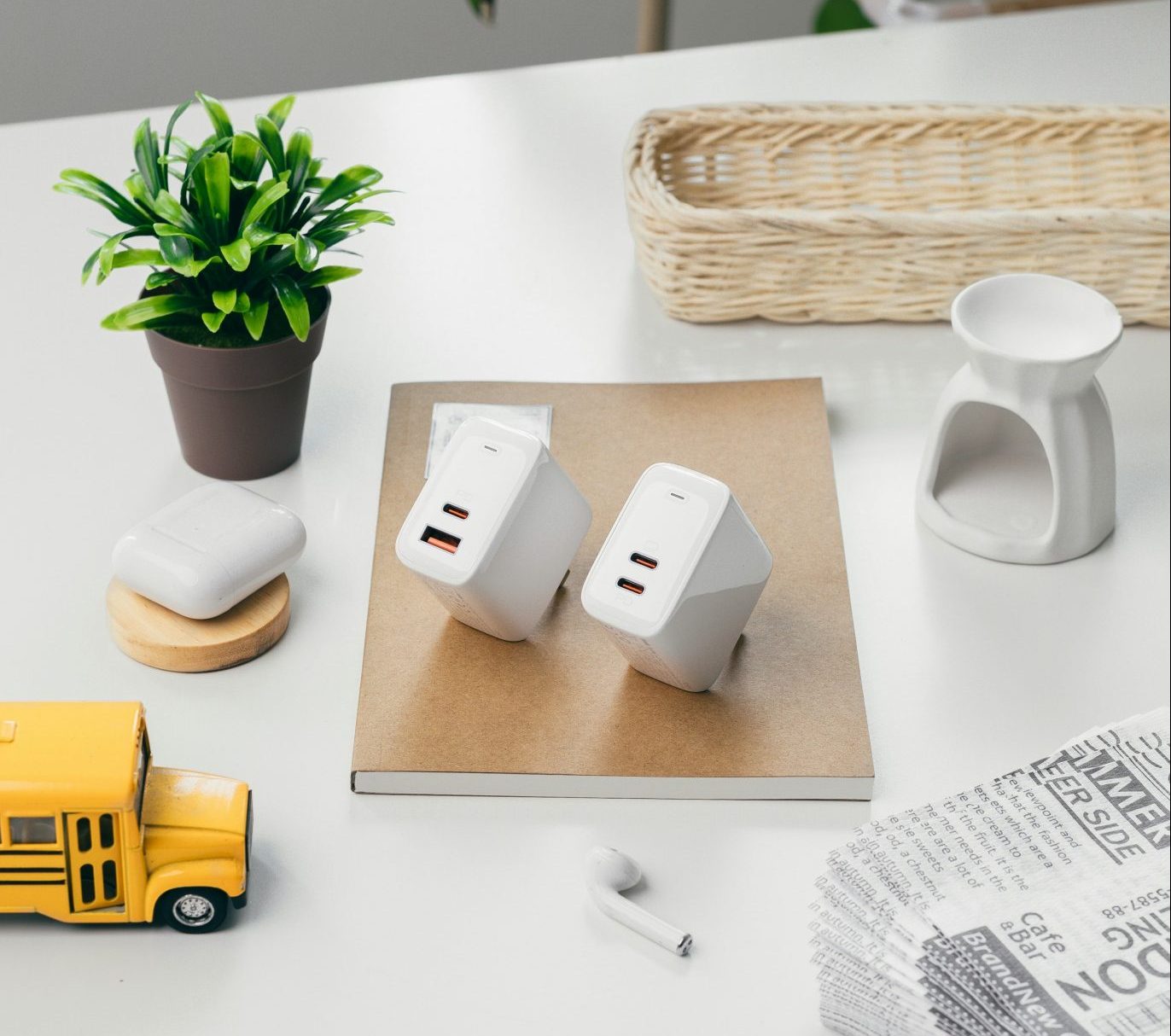
A wall charger is a device that plugs into a standard electrical outlet (like the ones in your home or office) and allows you to charge electronic gadgets such as smartphones, tablets, laptops, headphones, and more. These chargers convert the AC (alternating current) from your wall socket into DC (direct current), which your devices need to charge their batteries. ⚡
Key Components of a Wall Charger
- Plug: The part that connects directly to your power outlet.
- Charging Port(s): This is where you connect your charging cable. Modern chargers often feature USB-A and USB-C ports.
- Power Adapter: The internal part that transforms high-voltage electricity from the wall into a lower voltage suitable for your devices.
How Wall Chargers Work
When you plug your device into a wall charger, it draws power from the charger to charge your battery. Depending on the wattage of the charger, it will either charge quickly (fast charging) or more slowly. Most modern chargers are designed to work efficiently, delivering just the right amount of power without overcharging your device.
Wall chargers are the most common way people keep their devices powered up. They’re used everywhere – at home, in offices, hotels, airports, and cafes. You just need a working outlet and your device’s charging cable.
Why Wall Chargers Are Essential
- Convenience: You can charge your devices directly from any available power outlet, making it easy to keep your gadgets topped up throughout the day.
- Speed: Wall chargers are usually faster than charging through a laptop or computer’s USB port because they provide more direct power.
- Reliability: They are designed to provide a consistent, safe charge to your devices, ensuring they remain functional and battery life is preserved.
Most devices these days come with USB-C ports, which are quickly becoming the universal standard, while older gadgets may still rely on USB-A or proprietary ports like Apple’s Lightning cable. The great thing about many wall chargers is their ability to accommodate different types of devices with various charging speeds.
Types of Wall Chargers
- Standard Chargers: Basic models that deliver slower charging speeds, typically 5W or 10W.
- Fast Chargers: Deliver faster charging with higher wattages (18W, 20W, etc.), ideal for newer phones and devices that support quick charging.
- Power Delivery (PD) Chargers: High-powered chargers (30W and above) that can even charge laptops or power-hungry devices.
- Multi-Port Chargers: These chargers allow you to plug in multiple devices at once, saving you from needing separate chargers for each device.
Whether you’re looking for something simple for occasional use or a high-powered, multi-port charger for all your gadgets, wall chargers have evolved to meet every need.
🛠️ How to Choose the Right Wall Charger
Choosing the right wall charger might seem tricky with so many options out there, but it’s actually pretty simple once you know what to look for. Let’s break down the key things to consider so you can pick the perfect charger for your devices. 👍
⚡ Charging Speed
One of the most important factors to consider is how fast the charger can power up your devices. The speed is usually measured in watts (W). Here’s what you need to know:
- Standard Charging: Most basic chargers deliver 5W to 10W of power. This works fine for smaller devices, but if you’re in a hurry, it’ll feel slow.
- Fast Charging: Look for chargers with at least 18W or more for quicker charging. Many modern smartphones, like iPhones and Androids, support fast charging.
- Power Delivery (PD): If you need to charge larger devices like tablets or laptops, look for chargers with 30W to 100W. These chargers are much faster and can handle bigger gadgets.
🔌 Number of Ports
Do you have more than one device? Then consider how many ports the charger has:
- Single-Port Chargers: These are great for just charging one device at a time, like your phone or smartwatch.
- Multi-Port Chargers: If you need to charge multiple devices, go for a charger with 2, 3, or even 4 ports. These allow you to charge everything – your phone, tablet, and headphones – at the same time.
Multi-port chargers are especially useful if you’re in a family or group where everyone needs to charge their devices at once. 👨👩👧👦
🧑🔧 Type of Port
Modern devices use different types of ports, so make sure your charger has the right ones for your gadgets. The two most common types are:
- USB-A: This is the older, larger port that’s still used for many devices.
- USB-C: The newer, faster, and more powerful standard. Most smartphones, tablets, and laptops now use USB-C for charging.
If you have older devices, you might want a charger with both USB-A and USB-C ports. That way, you can charge both older and newer gadgets at the same time. 🔌
🔋 Compatibility with Your Devices
Not all chargers are created equal, and some devices need special chargers to work their best. Here’s what to keep in mind:
- Quick Charge Compatibility: Some devices, like certain Android phones, use Quick Charge technology for faster charging. Look for a charger that supports this if your phone has it.
- Apple Devices: For iPhones and iPads, make sure your charger has MFi certification (Made for iPhone/iPad). This ensures it’s fully compatible and safe for Apple products.
- Laptops: If you want to charge a laptop, make sure your charger is powerful enough (usually 30W or more). Not all wall chargers can handle the power needs of a laptop.
🛡️ Safety Features
Safety is super important when it comes to electronics, and a good charger will have built-in features to protect your devices. Look for these:
- Overcharge Protection: Stops charging once your device is full, so it doesn’t overheat or get damaged.
- Overcurrent/Overvoltage Protection: Prevents power surges from damaging your device.
- Heat Control: Chargers that keep cool are safer to use, especially for high-power devices like laptops. 🌡️
💼 Portability
If you travel a lot, you’ll want a charger that’s small and easy to carry. Compact chargers are lightweight and fit in any bag, but they might have fewer ports or lower charging speeds.
For home or office use, larger chargers with multiple ports might be more practical. But if you’re always on the go, portability should be high on your list. ✈️
💵 Price
Wall chargers range in price, but more expensive doesn’t always mean better. Here’s a quick guide to what you’ll get at different price points:
- Budget ($10-$20): Basic, single-port chargers with slower charging speeds. Good for basic needs.
- Mid-Range ($20-$50): Fast chargers with more ports and better compatibility with modern devices.
- High-End ($50+): High-power chargers that can handle multiple devices, including laptops. These usually have more safety features and better build quality.
Choose a charger that fits your budget and gives you the features you actually need.
🎉 Top 10 Wall Chargers: In-Depth Reviews
We’ve done the hard work of testing and researching the best wall chargers out there, and here are our top picks. Whether you’re looking for fast charging, multiple ports, or a budget-friendly option, we’ve got you covered with detailed reviews of the best wall chargers for your devices.
Anker PowerPort III Nano (20W)
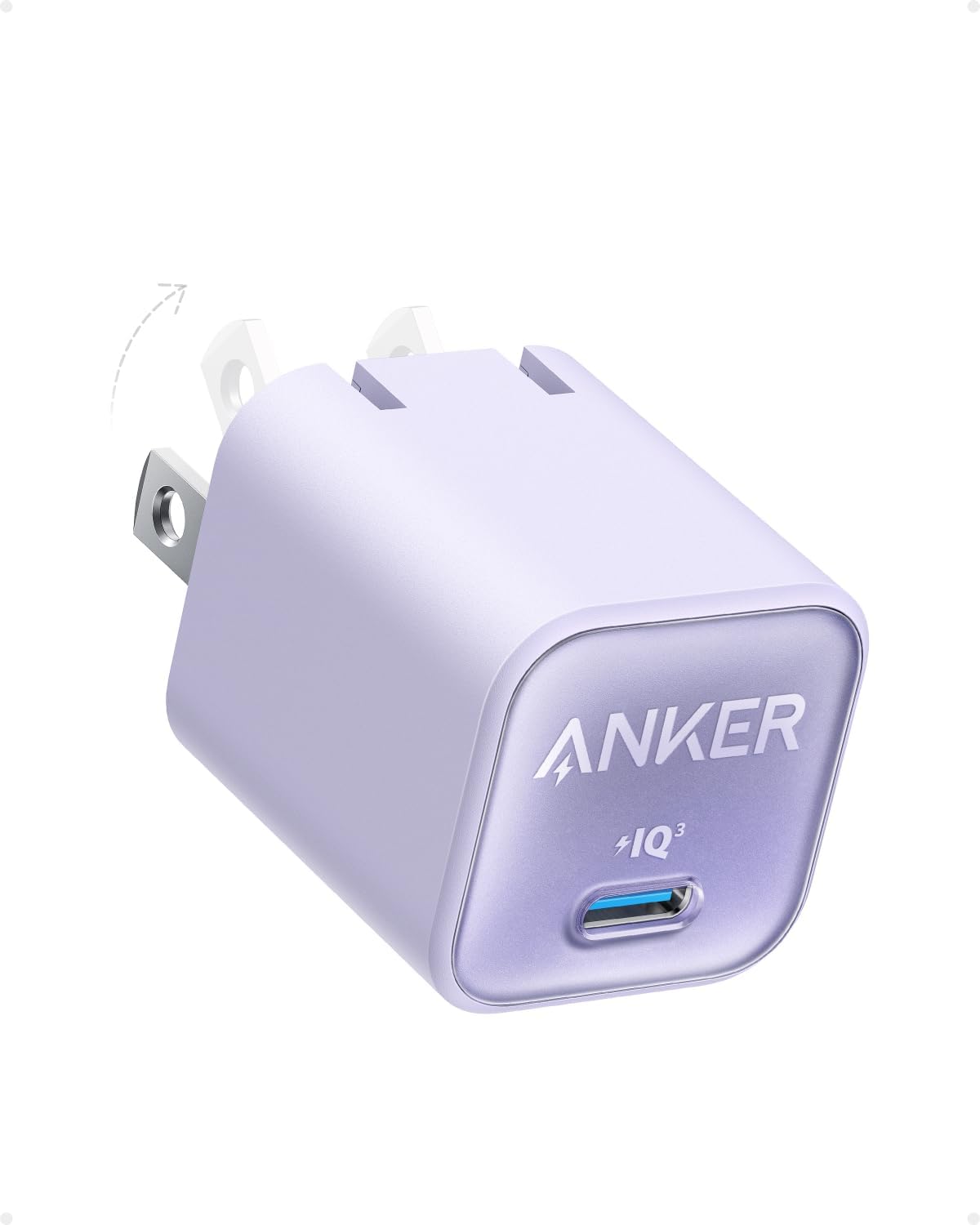
The Anker PowerPort III Nano is an excellent choice for those who want a compact and powerful charger. Despite its tiny size (it’s smaller than a golf ball!), it delivers an impressive 20W of power, which is perfect for fast charging most smartphones, including the latest iPhones and Android devices. This little powerhouse can charge an iPhone to 50% in just 30 minutes.
Its USB-C port makes it future-proof, and it’s small enough to easily fit in your pocket or bag, making it an ideal travel companion. However, it only has one port, so you’ll be limited to charging one device at a time. If you’re looking for portability and fast charging in a tiny package, this is one of the best choices on the market.
- Best for: Travelers and those who need a super compact charger for fast charging one device at a time.
- Pros: Super compact, 20W fast charging, great for iPhones.
- Cons: Single port, not ideal for multi-device users.
UGREEN GaN Charger (100W)
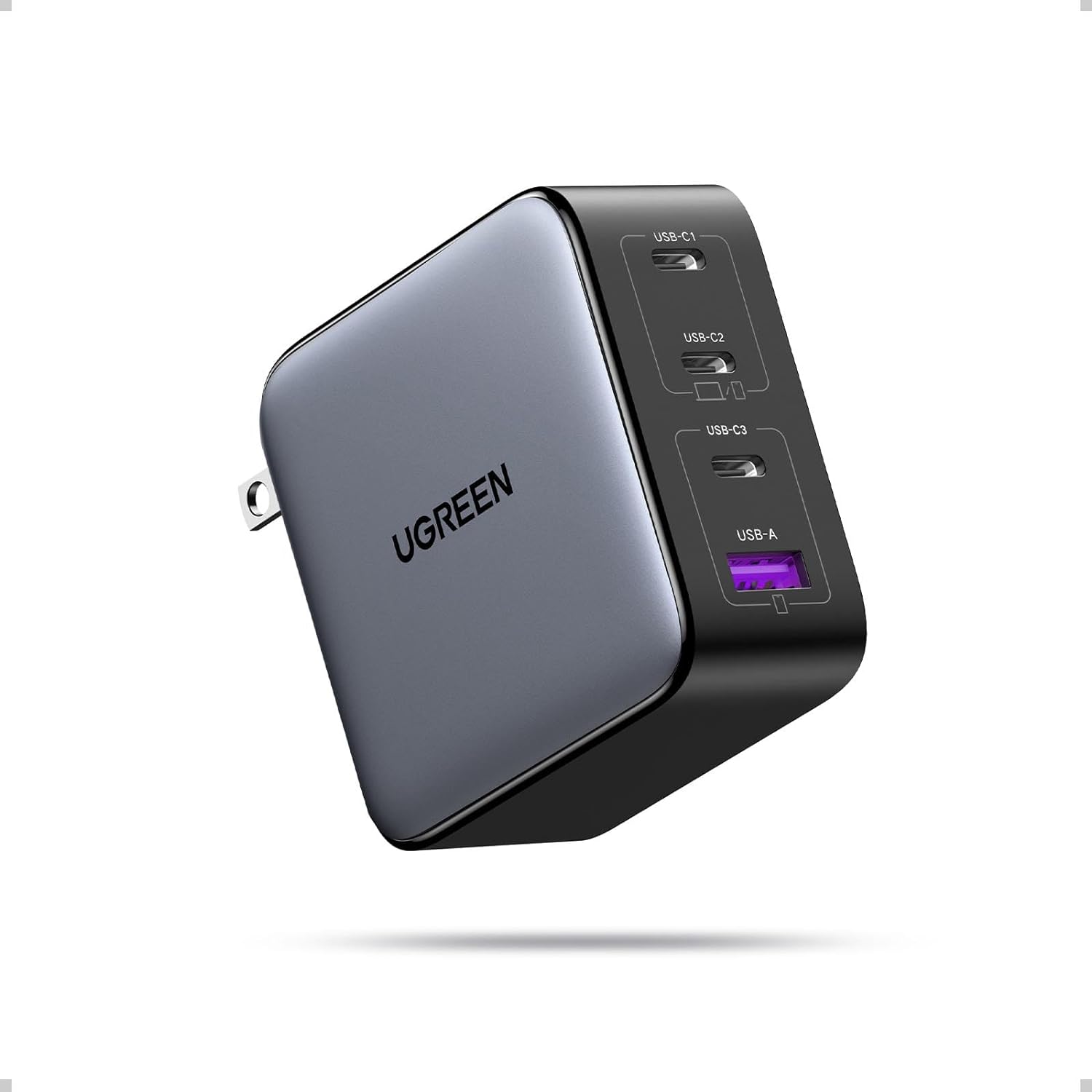
The UGREEN GaN 100W Charger is a powerhouse that uses Gallium Nitride (GaN) technology to deliver extremely efficient charging while keeping the charger cool. With a total output of 100W, this charger can handle even the most power-hungry devices, such as laptops, tablets, and phones, all at the same time. It has four ports: three USB-C and one USB-A, which makes it a fantastic option for users with multiple devices to charge.
The GaN technology allows it to be more compact than traditional high-power chargers while also improving energy efficiency. It’s perfect for tech enthusiasts who have a range of devices or professionals who need to keep everything charged, from their laptop to their phone and wireless headphones. While it’s on the pricier side, the UGREEN 100W GaN charger is a long-term investment that offers high performance and reliability.
- Best for: Heavy users with multiple devices, including laptops and tablets.
- Pros: 100W power, four ports, GaN technology, charges multiple devices at once.
- Cons: Expensive, still somewhat bulky compared to smaller models.
Apple 20W USB-C Power Adapter
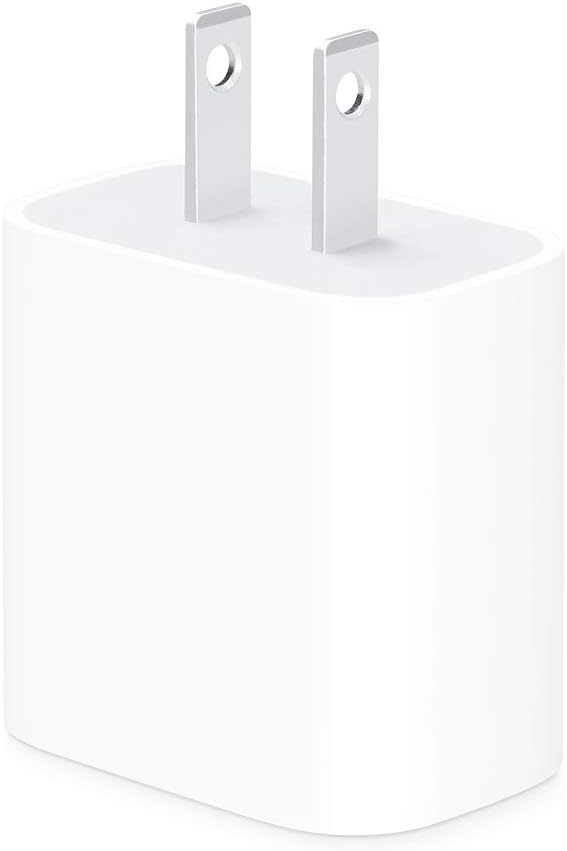
The Apple 20W USB-C Power Adapter is the go-to choice for iPhone and iPad users who want a charger specifically designed to work with their Apple devices. It’s perfect for fast charging, allowing you to charge an iPhone from 0% to 50% in about 30 minutes. This charger is built with Apple’s quality and reliability in mind, so you know your devices will be in safe hands.
While it’s designed for Apple devices, it works with other smartphones and tablets that support USB-C. However, it only has one port, which means you can only charge one device at a time. If you’re looking for a simple, reliable, and effective charger for your iPhone or iPad, this is a solid choice, though it lacks versatility compared to other chargers on this list.
- Best for: iPhone and iPad users looking for fast, reliable charging.
- Pros: Optimized for Apple devices, fast charging, simple design.
- Cons: Single port, limited to Apple-focused users.
Samsung 25W USB-C Super Fast Charger
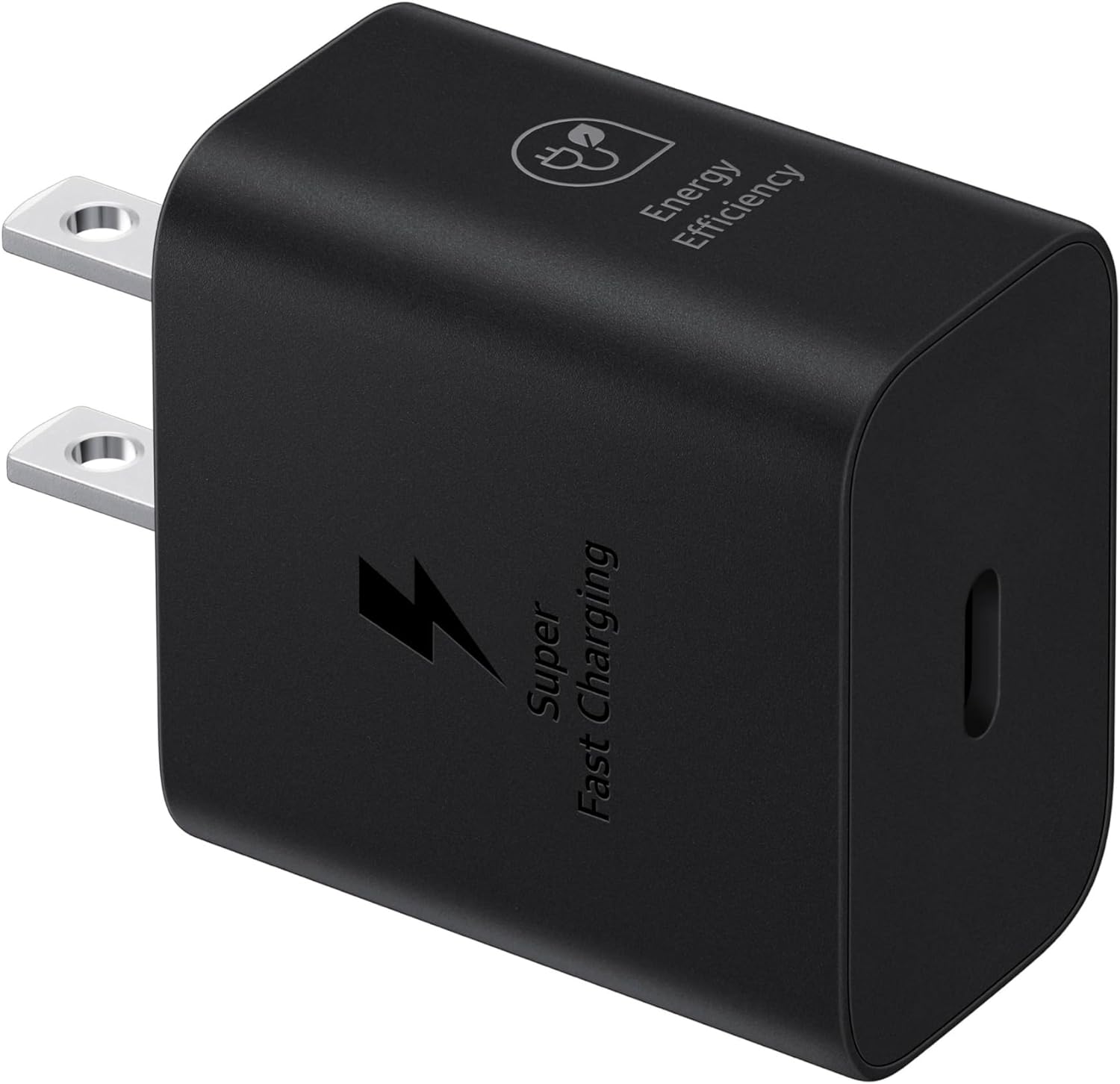
Samsung’s 25W USB-C Super Fast Charger is designed for Samsung Galaxy users but works with any USB-C compatible device. If you have a Samsung Galaxy S series or Note series phone, this charger is a must-have, as it delivers super-fast charging that can top off your phone in a flash. The charger uses USB Power Delivery (PD) to efficiently and safely deliver power to your device.
It’s compact and lightweight, making it a great everyday charger for home or on-the-go use. However, like many others in this range, it only features a single USB-C port, so you’ll be limited to charging one device at a time. For Samsung users, though, this is the best way to get the most out of your device’s fast charging capabilities.
- Best for: Samsung users who want the fastest charging possible for their Galaxy phones.
- Pros: Fast charging for Samsung Galaxy devices, compact design.
- Cons: Single port, not as versatile for multi-device users.
Belkin 32W Dual Port Charger
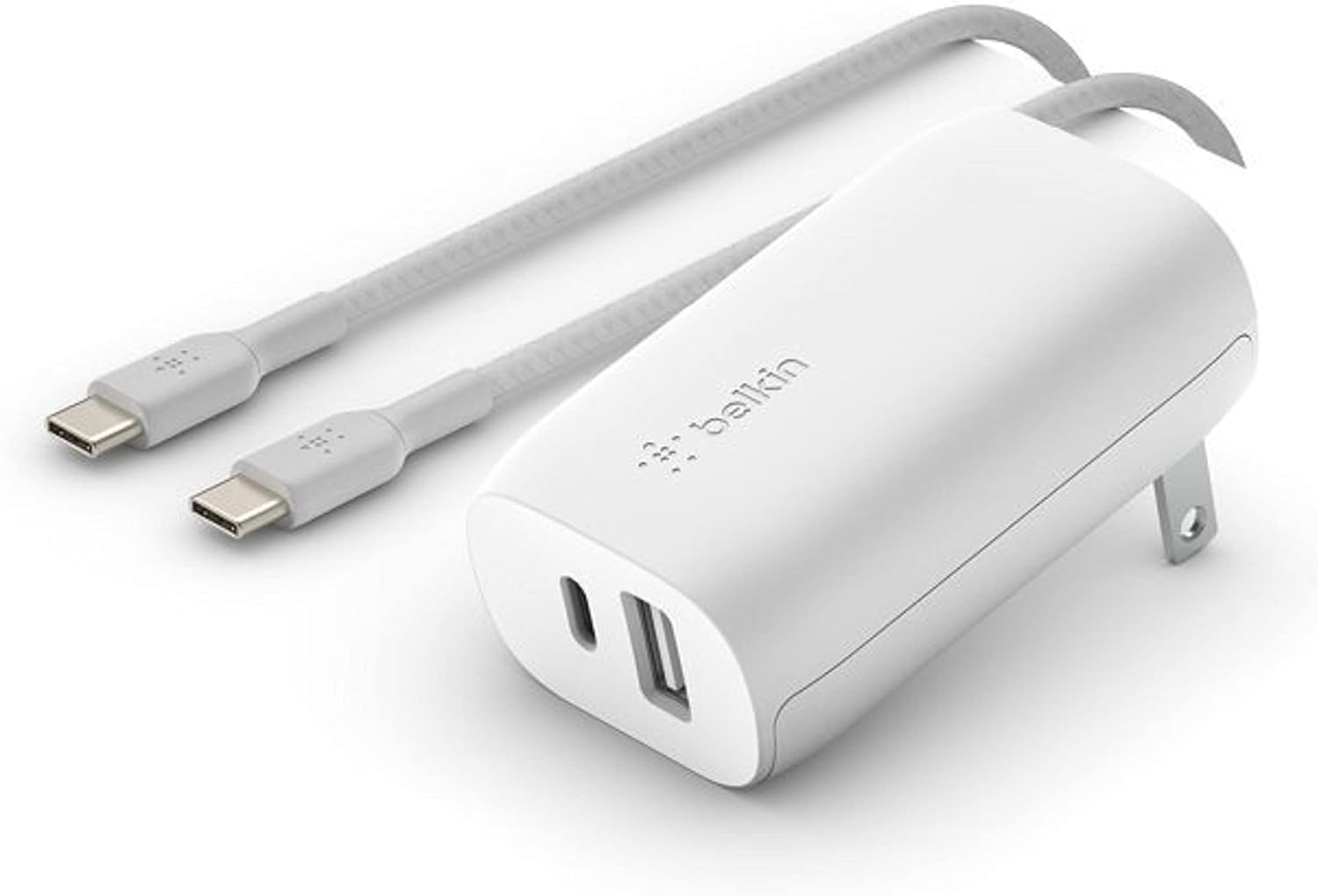
The Belkin 32W Dual Port Charger is a versatile charger that features both a USB-C port (20W) and a USB-A port (12W), making it ideal for those who need to charge both newer and older devices at the same time. The USB-C port offers fast charging for smartphones and tablets, while the USB-A port can handle accessories like headphones or older devices.
This charger is slightly larger than some of the ultra-compact options but is still small enough to easily carry around in your bag. It’s a great choice if you have a mix of devices with different charging needs. The balance of fast charging for modern devices and support for older gadgets makes it a solid all-rounder.
- Best for: Users with both new and old devices who want a single charger for both.
- Pros: Dual ports, fast charging for USB-C devices, affordable.
- Cons: Slower charging on the USB-A port.
Nekteck 65W USB-C Wall Charger
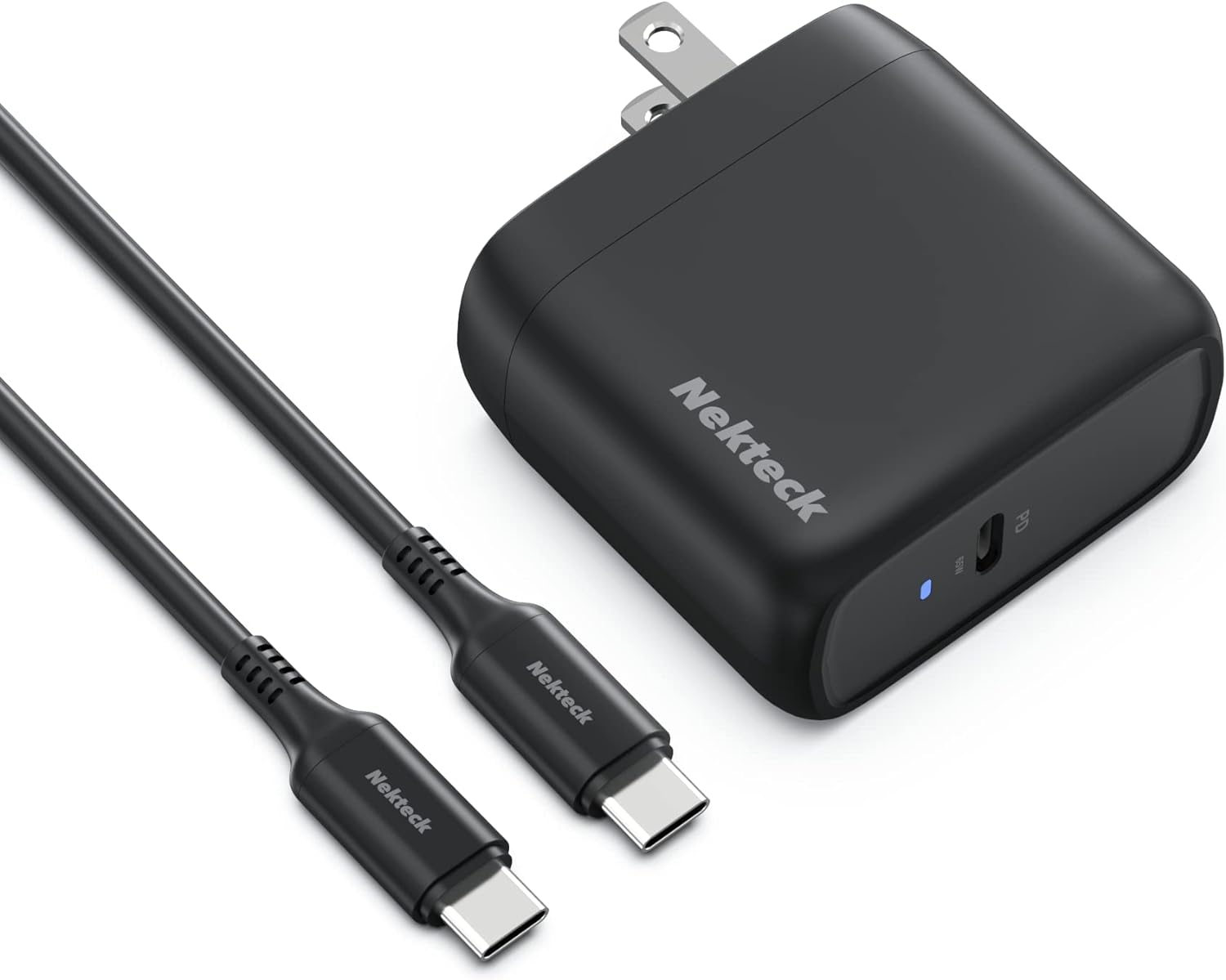
The Nekteck 65W USB-C Wall Charger is one of the best budget-friendly options for those who need to charge laptops, tablets, and smartphones. It offers 65W of power, which is enough to charge a MacBook Air, making it one of the more affordable high-power chargers. It also comes with a 6-foot USB-C cable, which is a bonus since many chargers require you to buy the cable separately.
Despite its power, the charger is fairly compact and features overcharge and overheating protection to keep your devices safe. It’s an excellent choice for those who need high power at an affordable price, though it only has a single USB-C port, so you can’t charge multiple devices at once.
- Best for: Budget-conscious users who need to charge laptops and phones.
- Pros: 65W power, includes a long cable, fast charging for laptops.
- Cons: Single port, larger than ultra-compact models.
Anker PowerPort Atom III Slim (30W)
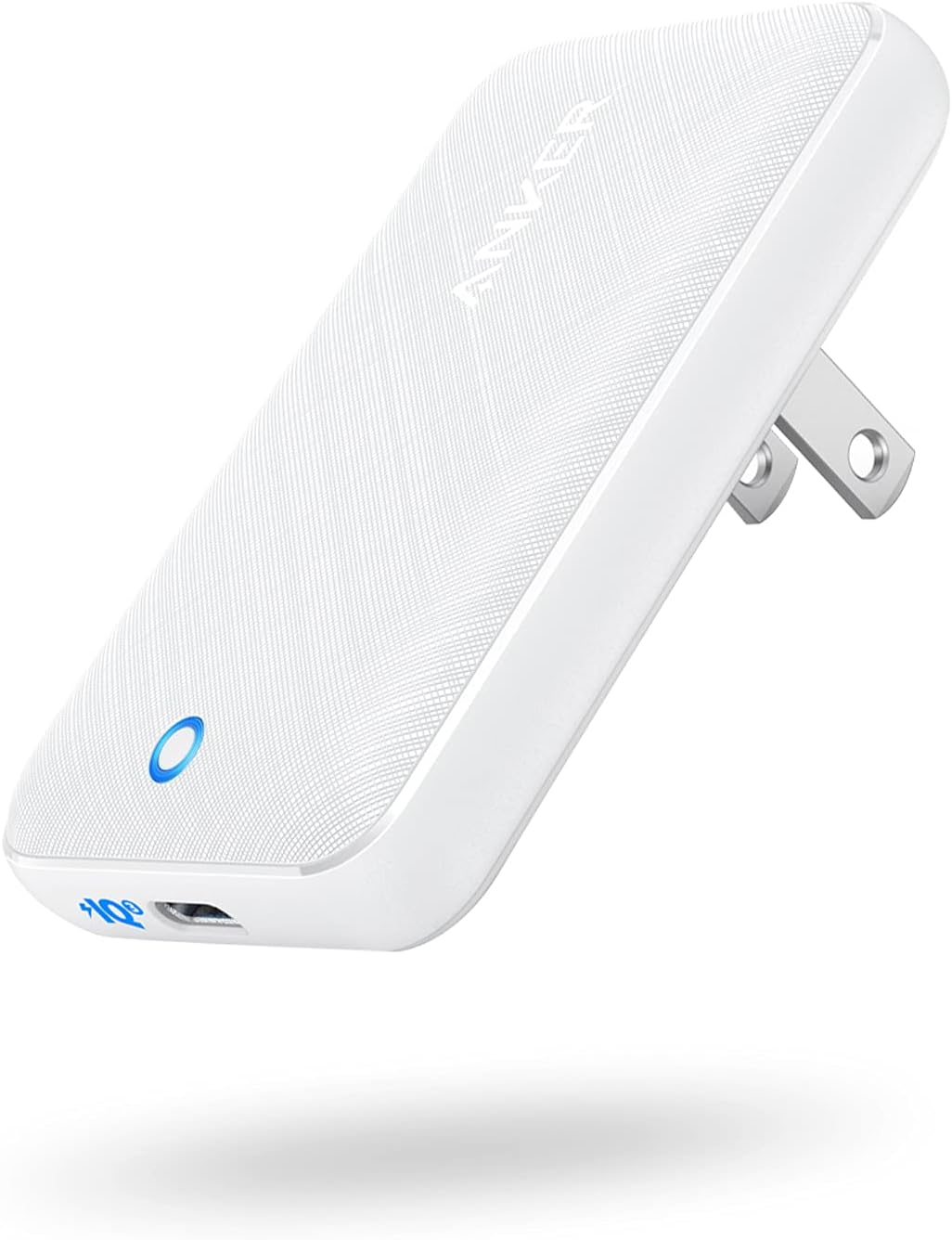
The Anker PowerPort Atom III Slim offers a sleek, slim design that’s perfect for people who don’t want to deal with bulky chargers. It delivers 30W of power through a USB-C port, which is enough to fast-charge smartphones and some smaller tablets. Its standout feature is its slim profile, making it one of the most portable high-performance chargers on the market.
This charger is ideal for daily use, whether you’re at home or on the go, and is lightweight enough to carry in a small bag or pocket. While it only has a single port, the combination of slim design and reliable fast charging makes it a top choice for those who prioritize portability.
- Best for: Users who want a slim, lightweight charger for daily use.
- Pros: Slim design, 30W fast charging, great for travel.
- Cons: Single port, limited power for larger devices like laptops.
Choosing the right wall charger depends on your needs, but with these top picks, there’s something for everyone. Whether you need to fast-charge a smartphone, keep multiple devices powered, or even charge a laptop, these chargers offer the best in terms of performance, safety, and convenience.
Be sure to consider the power output, number of ports, and whether the charger supports your specific devices before making a purchase.
🛡️ Safety Tips for Using Wall Chargers
While wall chargers are essential for keeping our devices powered up, using them correctly and safely is crucial to avoid damaging your devices or even causing hazards like overheating or electrical fires. Here are some important safety tips to keep in mind when using wall chargers:
1. Avoid Cheap or Counterfeit Chargers
It can be tempting to buy cheap, no-name chargers, but this is risky. Counterfeit chargers often lack the proper safety features and quality control, which can result in overheating, electrical shorts, or damage to your devices. Always buy from reputable brands and check for safety certifications like UL, CE, or FCC. These certifications ensure that the charger meets safety standards.
2. Don’t Use Damaged Chargers or Cables
If you notice that your charger or charging cable is frayed, cracked, or damaged, it’s time to replace it. Using a damaged charger can cause short circuits or even fires. This also goes for overheated chargers—if your charger gets excessively hot, unplug it immediately and let it cool down. Continuing to use a hot charger could lead to serious risks.
3. Unplug When Not in Use
Leaving a charger plugged in when it’s not charging anything can be dangerous. Chargers still draw power from the outlet even when not in use, and over time this could lead to overheating or wear and tear. To stay safe and save energy, make it a habit to unplug your charger when it’s not actively charging a device.
4. Keep Chargers Away from Heat and Moisture
Chargers should always be kept in a cool, dry place. Don’t place them near heat sources (like radiators or direct sunlight), and definitely avoid using them in damp or humid environments, like near sinks or in the bathroom. Water and electricity don’t mix, and moisture could lead to short circuits or shocks.
5. Use the Right Charger for Your Device
Make sure that the wall charger you are using is compatible with your device. For example, using a charger with too high a wattage can damage your device, while too low wattage might result in very slow charging. Check your device’s manual or specs to see the recommended charger type and wattage.
6. Look for Built-In Safety Features
When choosing a charger, look for ones that have important safety features, such as:
- Overcharge protection: Stops charging once the device is full, preventing battery damage.
- Overheat protection: Prevents the charger from overheating, which reduces the risk of fire or damage.
- Surge protection: Protects your devices from voltage spikes or electrical surges.
By following these tips, you can ensure that you’re using your wall charger safely, protecting both your devices and yourself.
🔄 Wall Chargers vs. Wireless Chargers: Which One Should You Choose?
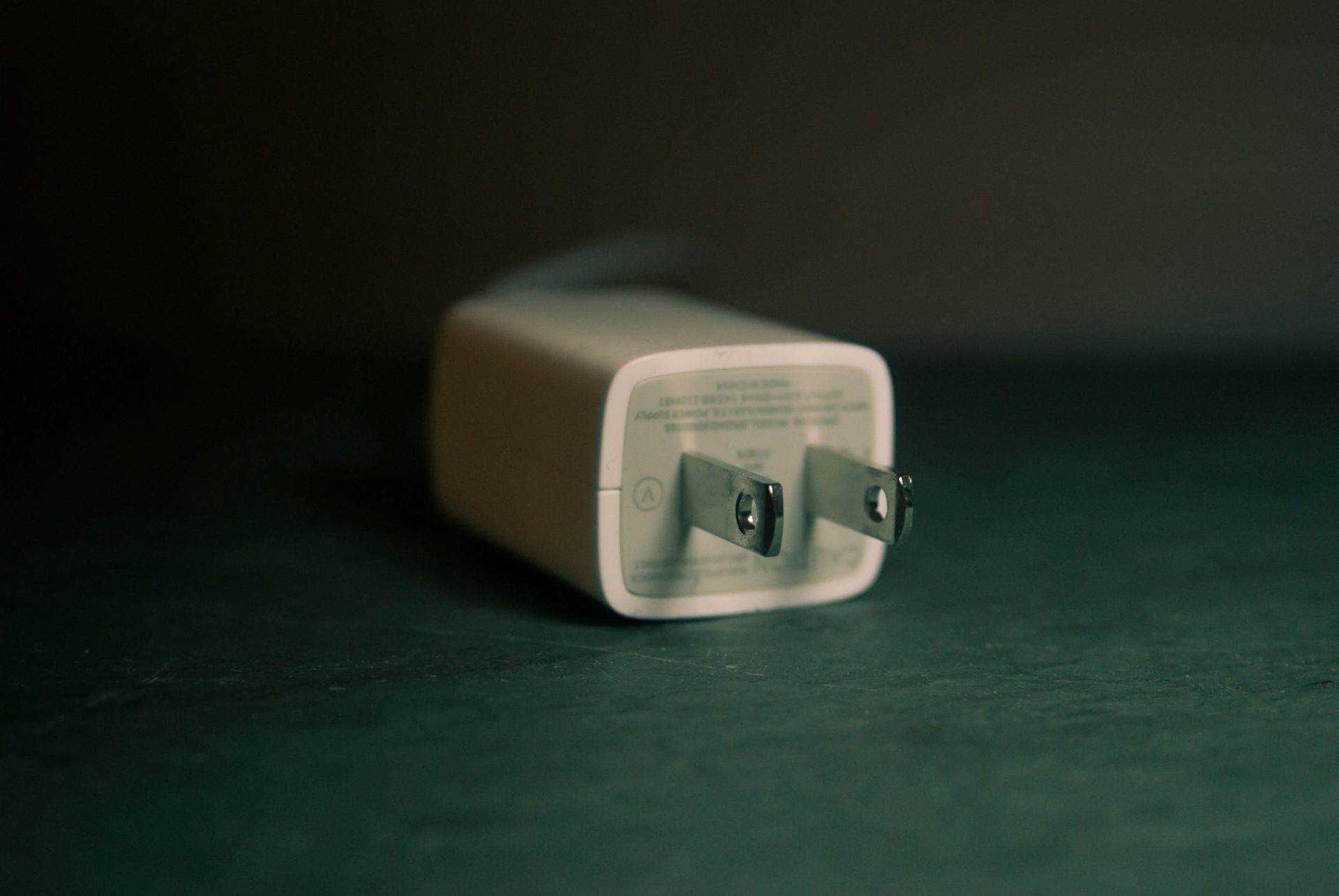
Both wall chargers and wireless chargers have their pros and cons, and choosing between the two depends on your needs and lifestyle. Here’s a detailed comparison to help you decide which is right for you.
⚡ Speed of Charging
- Wall Chargers: Wall chargers, especially those with fast-charging technology, are typically much faster than wireless chargers. With higher wattage (such as 18W, 30W, or even 65W), wall chargers can charge a smartphone from 0% to 50% in just 30 minutes. If you’re always in a hurry and need quick top-ups, a wall charger is the better option.
- Wireless Chargers: Wireless chargers are usually slower, with standard speeds around 5W to 10W, though some support up to 15W for fast wireless charging. They are ideal for overnight charging or situations where speed isn’t your main concern. Newer phones do support faster wireless charging, but it still doesn’t match the speed of a high-wattage wall charger.
Verdict: If speed is a priority, wall chargers win this round. If you don’t mind slower charging, wireless is more convenient.
🔌 Convenience and Ease of Use
- Wall Chargers: With wall chargers, you need to carry cables with you and physically plug your device in each time. This can be inconvenient when cables get tangled, lost, or wear out over time. On the plus side, they are portable and can be used almost anywhere you find an outlet.
- Wireless Chargers: Wireless chargers offer a lot more convenience. You simply place your device on the charging pad, and it starts charging without the need for cables. This makes them ideal for home or office desks, where you can easily set down your phone to charge and pick it up without fiddling with cords. However, they are less portable and require you to position your device just right on the pad for it to charge properly.
Verdict: For everyday convenience, wireless chargers are easier to use, but wall chargers are better for on-the-go charging.
🔋 Versatility
- Wall Chargers: Wall chargers are more versatile because they can charge a wide variety of devices, including phones, tablets, laptops, headphones, and more. With the right adapter or multi-port charger, you can charge multiple devices at once. Wall chargers also come in many wattage options, so you can choose one that’s suited for your specific needs.
- Wireless Chargers: Wireless chargers are usually limited to devices that support Qi wireless charging, such as most modern smartphones and a few other gadgets like wireless earbuds. They cannot charge larger devices like laptops or accessories that don’t support wireless charging, which makes them less versatile overall.
Verdict: Wall chargers are more versatile, as they can charge a broader range of devices.
🌍 Portability
- Wall Chargers: Wall chargers, especially compact models like the Anker Nano, are small and portable, making them perfect for travel. You can carry a single charger to power up your phone, tablet, and even laptop. Many come with foldable plugs for easier storage.
- Wireless Chargers: Wireless chargers tend to be less portable. They require a stable, flat surface and aren’t as easy to use on the go. While some wireless charging pads are compact, they generally don’t replace the convenience of a simple wall charger when you’re out and about.
Verdict: Wall chargers are more portable and travel-friendly.
🏆 Final Verdict: Which Should You Choose?
- Choose a Wall Charger if you need fast charging, versatility, and the ability to charge multiple devices. Wall chargers are also better for travelers and those who need their devices charged quickly.
- Choose a Wireless Charger if you prioritize convenience and don’t mind a slower charging speed. Wireless chargers are great for home or office use, where you can place your phone down and pick it up easily without dealing with cables.
For most users, it’s ideal to have both. A wall charger for fast charging when you’re in a rush and a wireless charger for the convenience of everyday use.
📖 FAQ: Wall Chargers – Everything You Need to Know
Choosing the right wall charger depends on your needs, whether you want fast charging, multiple ports for your gadgets, or something compact for travel. Wall chargers are great for speed and versatility, while wireless chargers offer convenience for everyday use. Always prioritize safety features and stick with trusted brands to keep your devices safe.
By understanding the charging speed, port types, and power requirements of your devices, you can find a charger that fits your lifestyle. With the options we’ve reviewed, you’re sure to find a charger that keeps you powered up.
